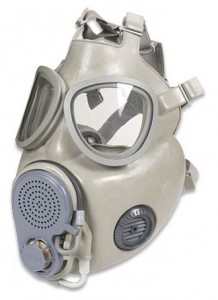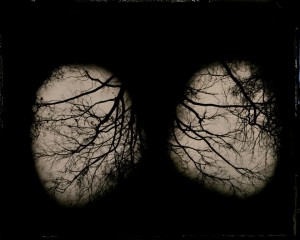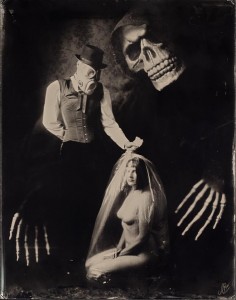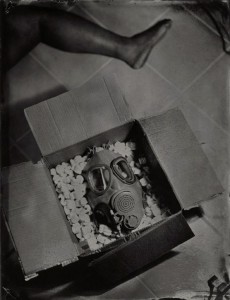 If you’ve been following this blog, then you already know that one of my goals of 2013 is to do more conscious thinking about creativity. What inspires it? What drives it? How can we tap in and harness it to enrich our lives? So I’m very grateful to have been granted a behind the scenes pass to a fascinating collaborative art project The Mask Series – an International Collaborative Art Project which is being curated by the American conceptual artist Shane Balkowitsch.
If you’ve been following this blog, then you already know that one of my goals of 2013 is to do more conscious thinking about creativity. What inspires it? What drives it? How can we tap in and harness it to enrich our lives? So I’m very grateful to have been granted a behind the scenes pass to a fascinating collaborative art project The Mask Series – an International Collaborative Art Project which is being curated by the American conceptual artist Shane Balkowitsch.
What you see here is a vintage Czech M10 gas mask. It’s the prop that Shane has chosen as the central focus for this global art endeavour.
THE CHALLENGE IS SIMPLE
Shane has issued an open invitation to photographers from all over the world to create wet plate collodion (link to your terms on the site) images using the M10 as a prop.
“Having every artist in the project use the same prop levels the playing field. Some artists may find it an inspiration, while others may view it to be a crutch or hindrance. Either way, the end result will be the unique vision of each individual artist.”
Since, amazingly, it turns out there are still one or two folk out there who don’t yet have vintage Czech gas masks of their own kicking about the place, Shane has bought up a supply, and is shipping them around the world, from photographer to photographer, in a sort of international gas-mask relay. Currently there are a dozen M10s in circulation around the world for The Mask Series. This means that even as you read this, somebody, somewhere is probably taking an old school photo involving an M10. To say nothing of the many artists who are sat there waiting for the postman…
From the moment I heard about this project, I was gripped by the creative possibilities. 
Not just because of the international scope – which is itself already taking on impressive proportions. (One month in, there are already 91 photographers committed to participating.)
There is no denying that gas masks are innately unsettling as objects. They bring instant associations of war and any number of ways of dying a horrible death. For objects which, by design, are life-saving devices, they are also a hideous distortion of human physiognomy.
Filmmakers have used them to excellent purpose for years, in nightmare sequences or even television programmes (allegedly) aimed at children, such as Doctor Who. Of course, here in the UK, it’s not unusual to hear the claim that we apparently lead the world in gas mask fetishes. Apocryphally, this is a leftover from the WWII when many young men experienced their early sexual awakenings in close quarters of air raid shelters and Tube stations. Although why this particular fetish should then still be prevalent among post-war Britons remains unexplained. However, what is clear, is that these wide ranging connotations are something the M10s carry with them even when – or perhaps especially when – they are viewed out of context.
THERE IS JUST SOMETHING ABOUT GAS MASKS
 And it’s already clear that, in coming months The Mask Series will be making a significant contribution into helping us gain a greater understanding as to just what that something is.
And it’s already clear that, in coming months The Mask Series will be making a significant contribution into helping us gain a greater understanding as to just what that something is.
One of the exciting things about the wide-ranging ambitions of this project is that the images are being made available by the artists as work progresses. You can bookmark the gallery and follow the Wet Plate Collodion Project on Facebook to keep up-to-date with what’s happening.
If the early results are any indication, The Mask Series is going to result in a lot of compelling and provocative work. Although the images are already about as different from each other as any curator could hope, the M10s are proving strangely cohesive.
“If the prop used for this process was a shirt or hat for instance, someone may not draw a line from one artist image to another’s. With the gas mask, the viewer will quickly realize the common thread amongst the pieces of work, and can then identify and understand the purpose of the collection.”
There is another natural link between gas masks and collodion photography which might not be obvious to anyone who has not actually been present at a wet plate shoot.
“The gas mask is also very symbolic to the wet plate process since many hazardous and caustic chemicals are used during the development of the images and most wet plate studios use gas masks on a daily basis.”
Knowing this makes the image Lungs, which Gerald Figal took through the M10 all the more astonishing. There are so many layers of ideas and connections here, from the notion of through the eyes of the mask, to the mask itself being the protector of breathing and lungs, the branches of the trees, the vessels in the lungs, and trees being symbols of life, and the lungs of the planet itself. It’s all there and more, and best of all, is just an enormously pleasing object to behold in it’s own right.
Similarly, Shane’s own work provokes the viewer into considering the fragility of existence. If you were holding the Last Flower, you’d be desperate to inhale the scent, and yet…
It’s a theme which Andreas Reh has also explored in his unsettling Breathless – a submission which sets the bar extremely high not just conceptually, but technically through multiple wet plate exposure. (In the interests of full disclosure, this last bit was pointed out to me by someone who actually does know what I’m meant to be talking about here…)
When I first started looking at the images in the gallery, I had begun to wonder if the M10, by the natural associations it carries, would somehow dictate that all the work in the series would necessarily take life and death as its theme. But then I saw the more playful Mail Fail /Male Fell by Heather Oelklaus and realised, it ain’t necessarily so.
Even from this brief selection of the enormous collection Shane is now amassing, it is clear that The Mask Series is already more than exceeding its stated aims.
As I write this, I understand that an M10 is already winging its way here. Should I be afraid? Probably.
More as it happens…


[…] you would like to know more about the Mask Series, please don’t hesitate to get in […]